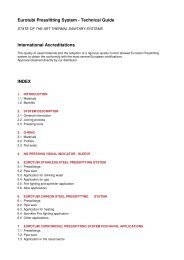corrosion of stainless steel - Damstahl
corrosion of stainless steel - Damstahl
corrosion of stainless steel - Damstahl
You also want an ePaper? Increase the reach of your titles
YUMPU automatically turns print PDFs into web optimized ePapers that Google loves.
Chapter 6 - Corrosion <strong>of</strong> Stainless Steel<br />
Figure 6.21:<br />
Crevice <strong>corrosion</strong> in press fitting (left) and tubes (right) <strong>of</strong> 4404 as a result<br />
<strong>of</strong> bacterial growth in tap water installation. The <strong>corrosion</strong> arose in water<br />
with a temperature <strong>of</strong> 45-50°C with less than 100 ppm <strong>of</strong> chloride, and it<br />
should be noted that the <strong>corrosion</strong> (the light grey areas on the right) has<br />
commenced in the narrowest places where the sleeve has been clamped<br />
around the tube.<br />
The effect <strong>of</strong> bacteria and biolayers is not, however, limited to sewage<br />
plants. All non-sterile media (i.e. nearly all media!) have the capacity for<br />
bacterial influence on the <strong>corrosion</strong> conditions, and even otherwise clean<br />
drinking water can hold unpleasant surprises. As the press fitting system<br />
was introduced more than 20 years ago, all pipes and fittings were made <strong>of</strong><br />
standard 4301 which should in theory be enough for cold tap water at least<br />
with chloride under 100-150 mg/l (see Figure 6.10 and Figure 6.18). This<br />
was not the case, and modern press fittings are all made <strong>of</strong> the superior,<br />
acid-resistant <strong>steel</strong> (4404). This works in by far most cases, but there are<br />
rare examples <strong>of</strong> bacteria (or combinations <strong>of</strong> bacteria) that are so aggressive<br />
that even acid-resistant <strong>steel</strong> will suffer from crevice <strong>corrosion</strong>.<br />
Molybdenum<br />
is good<br />
against crevice<br />
<strong>corrosion</strong><br />
6.3.2 Combating Crevice Corrosion<br />
Due to the slightly odd environmental conditions, the time factor, the effect<br />
<strong>of</strong> microbiology and the impossible task <strong>of</strong> creating a 'well-defined crevice',<br />
crevice <strong>corrosion</strong> is one <strong>of</strong> the most difficult forms <strong>of</strong> <strong>corrosion</strong> to fight. The<br />
alloying elements that best fight crevice <strong>corrosion</strong> are usually the same as<br />
the ones that are useful against pitting <strong>corrosion</strong>. A ranking <strong>of</strong> the various<br />
types <strong>of</strong> <strong>steel</strong> will therefore look very much like Table 6.1.<br />
But there are certain differences between pitting <strong>corrosion</strong> and crevice<br />
<strong>corrosion</strong>. Molybdenum passivates significantly better in oxygen-poor media<br />
(and thereby crevices) than chromium, and the <strong>steel</strong>'s molybdenum content<br />
should therefore be expected to mean more in crevice <strong>corrosion</strong> than pitting<br />
<strong>corrosion</strong>. From experience it can be seen that molybdenum is therefore even<br />
more important in combating crevice <strong>corrosion</strong> than pitting <strong>corrosion</strong>, and<br />
it should therefore be expected that the PREN factor between chromium and<br />
molybdenum in crevice <strong>corrosion</strong> would be higher than the 3.3 described<br />
in Eq. 6.1 and used in Table 6.1.<br />
105<br />
RS for alle.indb 105<br />
9/29/2011 12:44:41 PM

















